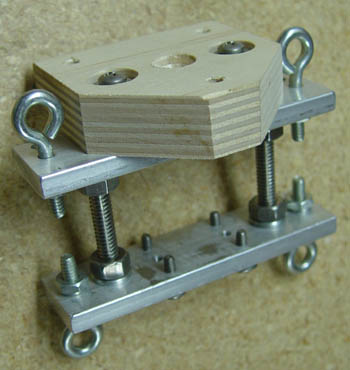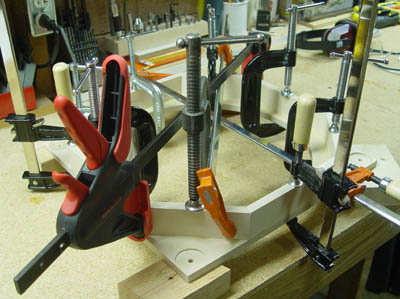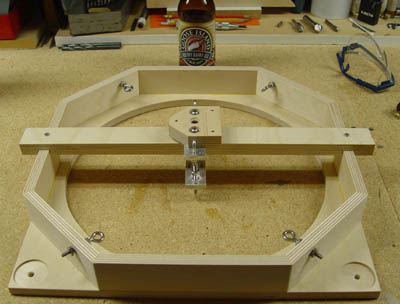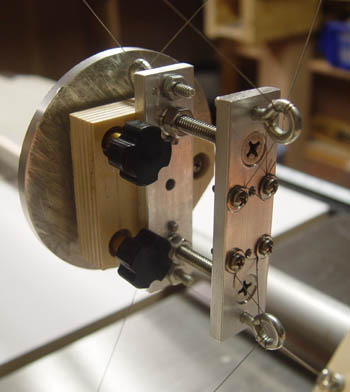Secondary cage and holder, offset wire spider
I think I am among the first to make an offset wire spider. I can
say that it works quite well. I am likely the first to use one on
a Cassegrain!
The secondary holder is composed of two 1/4" x 1" pieces of aluminum
just under 4" long, with four eye bolts threaded into the ends of the
aluminum. The eye bolts define the point where the two "legs" of the
spider meet. These points are NOT at the center of the hub, and
therefore this is an offset spider. (Texereau published plans for
an offset spider in his book many years ago. Others now are
trying to patent it!!) The most attractive feature of an offset
spider is its resistance to rotation. This is important in a
Newtonial, but slightly less important for a Cassegrain.
The aluminum is attached using two 1/4" diameter
stainless bolts and jam nuts. A piece of baltic birch is
attached, and the secondary mirror assembly is secured to it.
Rubber grommets are placed between the secondary mirror assembly and
the baltic birch on the central hub to permit tilt adjustments.
Here are two pictures of the secondary holder.


The secondary cage consisted of a square piece of 1/2" plywood with a
circle cut out of the center, forming the aperture of the telescope.
Eight pieces of 1/2" thick plywood are glued to it, forming an
octagonal ring that the wire spider is connected to with stainless
steel eye bolts. The wire
spider is "strung" with the aid of a jig, which consists of a piece of
3/4" thick plywood approximaely 16" long. The secondary holder is
jigged in the proper position, and half of the spider is strung with
one piece of wire, pulling the wire snug after each bend or wrap.
Then the eye bolts at each end of the spider "legs" (the ones in
the octagonal cage frame) are loosened, the
jig is removed, and the spider re-tentioned. Below are pictures
of the secondary cage glue-up, and the jig holding the secondary
holder.


Finally, here are two photos of the secondary holder, complete with
tentioned wire spider, from the front and the side. I used 0.015"
thick stainless wire for this spider. The ends of the wire are
held securely under washers that are tightened against the aluminum
with small machine screws (note the four screws and washers serving as
anchors in the center of the front aluminum piece in the photo below on
the right.) Other than these end anchors, the
wire only contacts the eye bolts. The sharpest bend
that the wire makes is around the 3/16" diameter of the eye
bolts. The
wire is generally wrapped once around each eye bolt for better
stability.


You might wonder if the 0.015" is strong enough to support the
secondary. My answer is yes, it is. I put one end of a
scrap of wire in my vise, and grabbed the other end with a pair of
needlenose pliers. I pulled, twisted, yanked, and did not break
the wire. After this test, I have complete confidence in the
spider.





